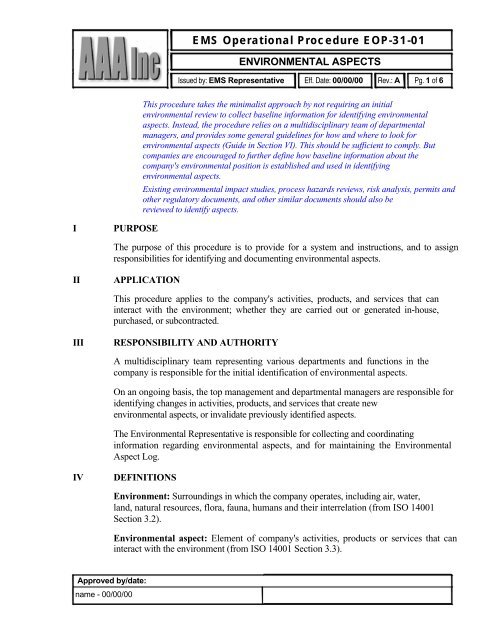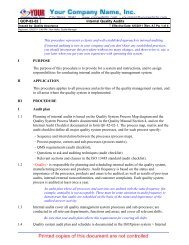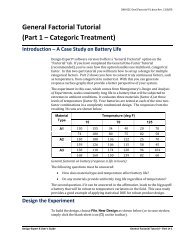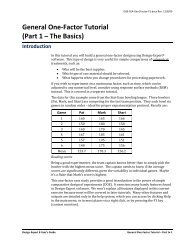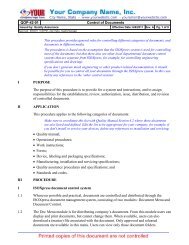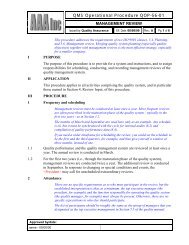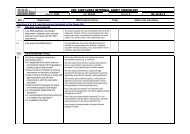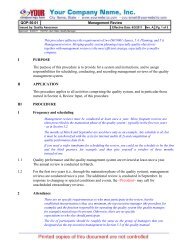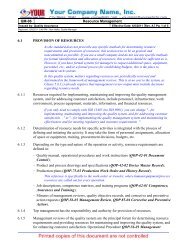Sample Procedures - Quality Coach
Sample Procedures - Quality Coach
Sample Procedures - Quality Coach
You also want an ePaper? Increase the reach of your titles
YUMPU automatically turns print PDFs into web optimized ePapers that Google loves.
ENVIRONMENTAL ASPECTSEMS Operational Procedure EOP-31-01 Rev.: A Pg. 2 of 6Environmental impact: Any change to the environment, whether adverse orbeneficial resulting from the company's activities, products and services (from ISO14001 Section 3.4).VPROCEDURE1. Initial Identification of Environmental Aspects1.1 In the initial phase of establishing and implementing the EMS, environmental aspectsare identified by a multidisciplinary team including representatives of variousdepartments and functions in the company. The Environmental Representative isresponsible for establishing and directing the team.External consultants and experts may also be included, or assist the team.1.2 Criteria and guidelines for identifying and selecting environmental aspects areprovided in Section VI of this procedure, Guide for Identifying and SelectingEnvironmental Aspects.1.3 Each member of the team inventories and reviews relevant activities, products, andservices in his or her department or area of expertise and, using the criteria defined inthe Guide (Section VI of this procedure) prepares a list of identified environmentalaspects. Environmental Representative coordinates the assignment of specific areasand types of activities, products, and services to ensure that everything is covered.1.4 Environmental aspects identified by the team are discussed at a special meetingchaired by the Environmental Representative. Each member of the team presents hisor her aspects and the team evaluates whether the aspects are relevant and fit thedefinition, guidelines, and criteria provided in Guide in Section VI of this procedure;and that there are no duplications. The Environmental Representative notes all aspects thatpass the evaluation and compiles a combined, comprehensive list of allenvironmental aspects.1.5 The combined list is then presented to the top management for review and for possibleidentification of additional aspects that may have been missed.This review could also include the legal counsel, or someone else with the knowledge ofenvironmental laws and regulations and the environmental compliance history of thecompany.1.6 The final list of environmental aspects identified by this initial review is recorded inthe Environmental Aspect Log.2. Ongoing Identification of Environmental Aspects2.1 Changes and development of new activities, products, or services may invalidatepreviously identified environmental aspects or require the addition of new aspects to thelist. Examples of such changes include:
ENVIRONMENTAL ASPECTSEMS Operational Procedure EOP-31-01 Rev.: A Pg. 3 of 6• Modification of product design and development of new products;• Changes in processes and technology, and introduction of new processes;• Significant expansion or reduction of capacity;• New suppliers and subcontractors;• Plant addition or relocation;• Changes in the surrounding community;• Changes in laws and regulations (that would promote higher awareness of certainaspects);• Temporary projects, such as construction, installation of new lines or equipment, andso forth.Edit this list to reflect the types of changes and developments that would be relevant in yourcompany.2.2 On ongoing basis, the top management and departmental managers are responsible foridentifying changes in activities, products, and services that either create newenvironmental aspects or invalidate previously identified aspects.2.3 New environmental aspects may also be identified through the management review orby internal or external audits of the EMS.2.4 New environmental aspects, and requests to delete obsolete aspects, are communicatedto the Environmental Representative.2.5 The Environmental Representative reviews the proposed aspects for relevance andconformance with the definitions, guidelines, and criteria provided in the Guide inSection VI; and records the new aspects in the Environmental Aspect Log.3. Environmental Aspect LogThe Environmental Aspect Log is not explicitly required in the standard. However, asidentification of aspects initiates the whole process of selecting significant aspects anddefining objectives, targets and management programs for the EMS, auditors will expectthis first step to be well controlled.An alternative system for communicating and recording new environmental aspects couldbe based on a form similar to those used for requesting changes in engineering documentsor for requesting corrective actions. Such form would be filled out by the person whoidentifies a new environmental aspect, and then be forwarded to theEnvironmental Representative for further processing. Evaluation of significance of theaspect could be also recorded on the same form.3.1 Environmental Aspect Log is used for recording initial and new environmentalaspects, and invalidating previously identified aspects that are no longer valid. The log isin the form of a matrix for recording the following information:• Date - the date on which the aspect is identified (or invalidated)
ENVIRONMENTAL ASPECTSEMS Operational Procedure EOP-31-01 Rev.: A Pg. 4 of 6• Aspect - description of the aspect• Change - description of the change that creates the new aspect (write INITIAL ifaspect is identified by the initial review)• Deletion - reason why the aspect is invalidated (use only to invalidate aspects)• Approval - signature of the Environmental RepresentativeVIGUIDE FOR IDENTIFYING AND SELECTING ENVIRONMENTALASPECTS1. GeneralThe purpose of this guide is to provide criteria, methods and guidelines forimplementing the procedure. Its role is to prepare (train) the environmental team tobetter understand the concepts and issues related to environmental aspects.1.1 The purpose of identifying environmental aspects is to create a broad inventory ofactivities, processes, materials, products, and services — or their elements — that canpossibly impact the environment.1.2 At this stage, the significance of an aspect should not be considered. This will be doneat the next stage, when significance will be formally evaluated for each individualaspect (refer to Section V PROCEDURE). However, while at this stage we want abroad pool of all possible aspects, we have to avoid trivializing this process. If anaspect is so trivial — in relation to other aspects — that it obviously does not makeany sense to even subject it to a formal evaluation of significance, it should not bebrought up.2. Guidelines and Criteria for Identifying Environmental Aspects2.1 The following categories of activities and products are considered and reviewed toidentify environmental aspects:• Production processes and operations• Storage and handling of materials and products• Equipment maintenance• Facilities operation and maintenance• Transportation and transportation equipment• Company's products and services (life cycle considerations)• Purchased (or subcontracted) products and servicesEach category is further broken down into specific activities and products, asapplicable for individual departments.Edit this list to reflect the actual types of activities and products in your company.2.2 Activities, products, and services are analyzed for potential impacts on the
ENVIRONMENTAL ASPECTSEMS Operational Procedure EOP-31-01 Rev.: A Pg. 5 of 6environment by considering the following questions:• What materials, chemicals, agents, or other substances are used in (or required for)the given activity, process, product, or service? Are these substances used insubstantial quantities? What would be the consequence of injecting these substancesinto the environment (accidental or controlled release, spill, disposal to landfill,etc.)?• Does the activity, process, product, or service generate any waste (leftovermaterials, by-products, emissions, contaminated water, sludge, trash, etc.)? Is the wastegenerated in considerable quantity? What would be the consequence ofinjecting the waste into the environment (accidental or controlled release, spill,disposal to landfill, etc.)? Is the waste recycled? How is the waste disposed? Is there anenvironmental impact caused by disposal of the waste?• Does the activity, process, product, or service generate noise, dust, unpleasant odor,unsightly environment, or other nuisance for neighbors and the surroundingcommunity?• Does the activity, process, product, or service consume considerable energy, water, orother natural resources? Are these resources renewable? Does extraction of the resourceshave considerable impact on the environment?• Is the manufacture of materials used in the product causing depletion of naturalresources? Is the packaging of the product recyclable or biodegradable? In service, is theproduct using excessive energy, or emitting substances that can impact theenvironment? Can servicing or maintenance of the product cause environmental impact?How is the product disposed at the end of its life? Are materials used in the productrecyclable or biodegradable?2.3 Environmental aspects of activities and processes are also considered in abnormal andunusual operating conditions — for example, start-up, shutdown, cleaning,maintenance, malfunction, accidents and emergencies, etc.2.4 When identifying environmental aspects, the question is not only whether the activity,product, or service actually impacts the environment, but also whether it canpotentially impact the environment. An aspect may be prevented from impacting theenvironment because of implemented operational controls, such as containment curbs,deployment of special equipment or containers, maintenance and inspection ofequipment, alarms and automatic shutdown mechanisms, personnel training, and so forth.However, if these controls are removed or are not properly maintained, theaspect could create an environmental impact. For this reason, environmental aspects mustbe considered irrespective of existing operational controls. Once the aspect is identified,these controls may be then integrated into the EMS.3. Degree of Control and Influence Over Environmental Aspects3.1 Only those environmental aspects that can be controlled by our company and overwhich the company can be expected to have influence are relevant. Identification of
ENVIRONMENTAL ASPECTSEMS Operational Procedure EOP-31-01 Rev.: A Pg. 6 of 6aspects that we cannot influence does not make any sense, because our EMS will not beable to do anything about them.3.2 Typically the types of activities, products, or services that the company cannot controlare those that are determined by others, over whom we have no direct influence; andwhen there is no realistic choice of using alternative materials, products, processes,technologies, or methods. For example:• Aspects related to product characteristics when the company cannot influenceproduct design and specification.• Aspects related to the manufacture and delivery of purchased materials, products orservices when the company has no influence over the manufacturing or deliverymethods and when there are no equivalent alternative materials, products, orservices.• Aspects inherent in a process technology when there are no alternative technologies orwhen the technology cannot be changed for economic or competitive reasons (in this casethe degree of impact of an aspect can be still controllable).VIIASSOCIATED DOCUMENTS• Significant Environmental Aspects — Oper. Proc. EOP-31-02• EMS Management Review — Oper. Proc. EOP-60-01
EMS Operational Procedure EOP-31-02SIGNIFICANT ENVIRONMENTAL ASPECTSIssued by: EMS Representative Eff. Date: 00/00/00 Rev.: A Pg. 1 of 5IPURPOSEThe purpose of this procedure is to provide for a system and instructions, and to assignresponsibilities for evaluating significance of environmental aspects. (The actualcriteria and method for evaluating significance of aspects are provided in Section VI,Guide for Evaluating Significance of Environmental Aspects.)IIAPPLICATIONThis procedure applies to all environmental aspects of company's activities productsand services.IIIRESPONSIBILITY AND AUTHORITYA multidisciplinary team representing various departments and functions in thecompany is responsible for evaluating significance of initial environmental aspects.For new aspects, evaluation of significance is carried out by the EnvironmentalRepresentative and at least one other person familiar with the evaluated aspect.Top management reviews and approves initially selected and new significantenvironmental aspects.Formal approval is not required, but it may be appropriate. This issue is furtherdiscussed in other notes under relevant sections.IVDEFINITIONSSignificant Environmental Aspect: An environmental aspect that has or can havesignificant environmental impact (from ISO 14001 Section 3.3).VPROCEDURE1. General1.1 The purpose of evaluating significance of environmental aspects is to select a group ofaspects that will become the focus of the EMS, and for which our company willconsider implementing special controls and monitoring systems, and may developenvironmental objectives and targets. This group of aspects defines the direction of ourenvironmental effort and allocation of resources for the protection of theenvironment.1.2 While the evaluation of significance of environmental aspects is carried out using asystematic and deliberate process, logic and judgment must also be used in the finalApproved by/date:name - 00/00/00
SIGNIFICANT ENVIRONMENTAL ASPECTSEMS Operational Procedure EOP-31-02 Rev.: A Pg. 2 of 5selection. The systematic process alone cannot absolutely guarantee correct results.2. Evaluation of Significance of Initial Environmental Aspects2.1 In the initial phase of establishing and implementing the EMS, significance ofenvironmental aspects is evaluated by a multidisciplinary team includingrepresentatives of various departments and functions in the company. TheEnvironmental Representative is responsible for establishing and directing the team.This is normally the same team, or part of the team, that identified the initial aspects, perProcedure EOP-31-01.2.2 Significance of environmental aspects is evaluated using a systematic risk analysismethodology. Aspects are rated with regard to the severity of associated impacts,probability of occurrence, and other relevant factors. The results are entered on theEnvironmental Aspect Evaluation Chart, and the combined significance rating iscalculated using a special formula.2.3 The Guide for Evaluating Significance of Environmental Aspects in Section VI of thisprocedure explains the rating system, provides a form for the Environmental AspectEvaluation Chart, and defines the formula for calculating the combined significancerating.2.4 After the evaluation charts are completed and the significance rating is established foreach aspect, the team goes over the list again to verify that the results of the analysismake sense and are generally in agreement with the intuitive judgment of the team.The significance rating system is just a tool to help understand different issues relatedto the aspect. The final classification of the significance of an environmental aspect isa decision that the team members have to make following their own judgment.2.5 Certain categories of environmental aspects are automatically classified as significantaspects, irrespective of other factors. Criteria for this priority significanceclassification are defined in the Guide in Section VI.2.6 The completed evaluation charts are then presented to the top management for reviewand for possible identification of additional significant aspects that may be dictated bypolicy considerations.This review could also include the legal counsel or someone else with the knowledge ofenvironmental laws and regulations and the environmental compliance history of thecompany.2.7 The evaluation charts with the final selection of significant environmental aspects areapproved and signed off by the Environmental Representative and by the President ofthe company.The standard does not require formal approval of the list and does not identify any levelof authority for such approval. However, as the whole direction of the EMS, including theenvironmental policy, will be dictated by the significant aspects, formal approval by thetop executive is appropriate.
SIGNIFICANT ENVIRONMENTAL ASPECTSEMS Operational Procedure EOP-31-02 Rev.: A Pg. 3 of 53. Ongoing Evaluation of New Environmental Aspects3.1 New aspects added to the Environmental Aspect Log (refer to Procedure EOP-31-01,Environmental Aspects) are evaluated by the Environmental Representative and atleast one other person who is most familiar with the aspect. In complex cases, or when alarger number of diverse aspects need to be evaluated, the EnvironmentalRepresentative assembles a multidisciplinary team to carry out the evaluation.3.2 The evaluation is carried out using the Environmental Aspect Evaluation Chart, andthe same methods and criteria as defined for the evaluation of initial environmentalaspects (refer to the Guide in Section VI).3.3 The completed evaluation chart is then presented to the top management for reviewand for evaluation against policy considerations.This review could also include the legal counsel or someone else with the knowledge ofenvironmental laws and regulations and the environmental compliance history of thecompany.3.4 When a new significant aspect is selected, the Environmental Representative and thePresident of the company approve and sign off the evaluation chart.The standard does not require formal approval of new significant aspects. However,as the whole direction of the EMS, including the environmental policy, will be dictatedby the significant aspects, formal approval by the top executive is appropriate.4. Significant Environmental Aspect Master List4.1 Approved significant environmental aspects are listed in the SignificantEnvironmental Aspect Master List maintained by the Environmental Representative.VIGUIDE FOR EVALUATING SIGNIFICANCE OF ENVIEONMENTALASPECTSRating systems and mathematical formulas for determining significance of aspects do notwork very well and must be very carefully tuned to give reasonable results. The systempresented in this procedure is just an example of how a systematic evaluation could bemodeled. But the final system must be worked out by each individualcompany to suit its circumstances.Do not hesitate to change categories, rating values, and the formula. If you cannotachieve satisfactory results with the mathematical approach, you don't have to use amathematical formula at all. It is sufficient to just tabulate the aspects and theirindividual category ratings without calculating results. A graphical presentation ofratings can also be used. The standard only requires that a rational and objectiveevaluation process be applied.1. Environmental Aspect Evaluation Chart1.1 Significance of environmental aspects is evaluated using the Environmental AspectEvaluation Chart enclosed at the end of this guide.
SIGNIFICANT ENVIRONMENTAL ASPECTSEMS Operational Procedure EOP-31-02 Rev.: A Pg. 4 of 51.2 After ratings for individual attributes and the total significance rating for an aspect arecalculated, the actual significance designation for the aspect is marked in the firstcolumn, Aspect Significance Designation.2. Significance Rating2.1 Significance rating of an aspect is determined by calculating the associated risk (R)and combining it with ratings of other factors:Significance Rating = R + E +F + G + H + I2.2 There is no threshold defined for significance rating above which an environmentalaspect would be automatically classified as significant. The rating is only a tool forbetter understanding issues related to the aspect. The final classification of thesignificance of an environmental aspect is a decision of the evaluators and the topmanagement.3. Priority Significance Classification3.1 Three categories of significant aspects are automatically classified as significant,irrespective of other factors. These categories are:• High severity of environmental impact: When the aspect can cause long term orpermanent damage to the environment extending outside the facility (A = SIG).• High legal/regulatory priority: When laws or regulations pertaining to the aspectrequire periodical reporting of performance or operational data, operating permits, orcontingency planning (E = SIG).• Policy priority: When the top management decides that the aspect has a specialrelevance with policies and aspirations of the company (I = SIG).4. Risk Rating4.1 Every environmental aspect is first rated with regard to the risk it poses to theenvironment. The risk is calculated as a product of severity of impact and probabilityof occurrence.4.2 Severity of an impact has two components: severity of impact on the environment andseverity of impact on human health and safety.4.3 ………..The remainder of this significance rating method is not included in the DEMOversion of the software. The missing portion instructs how to determine ratingsrelated to:
SIGNIFICANT ENVIRONMENTAL ASPECTSEMS Operational ProcedureEOP-31-02Rev.: A Pg. 5 of 5• Severity of environmental impact• Severity of impact on humans• Probability of occurrence• Complexity of operational controls• Legal/Regulatory Requirements• Nuisance• Views of interested parties• Lack of information• Policy issuesVIIASSOCIATED DOCUMENTS• Significant Aspect Evaluation Chart — QF-31-01-1• Environmental Aspects — Oper. Proc. EOP-31-01• EMS Management Review — Oper. Proc. EOP-60-01
EMS Operational Procedure EOP-32-01LEGAL AND OTHER REQUIREMENTSIssued by: EMS Representative Eff. Date: 00/00/00 Rev.: A Pg. 1 of 8This procedure is designed for small and medium size service or light manufacturingfacilities where there are no in-house experts in environmental law, but the issues may besufficiently simple to be handled by a non-expert.In facilities where there is either in-house expertise on environmental law, or wherethe management decides right away to retain an environmental attorney or contractthis project to an expert consultant, the procedure may be greatly simplified. In thiscase there is no need for the initial identification of compliance programs,preliminary research, preliminary research survey, and management review todetermine how to proceed (although the same steps will probably be taken by theconsultant). Instead, the procedure should specify how attorneys/consultants areselected and who coordinates the work of outside experts. Sections instructing on how todocument the list of applicable regulations and how to track changes in activitiesor laws must be retained in any circumstance.IPURPOSEThe purpose of this procedure is to provide for a system and instructions, and to assignresponsibilities for identifying federal, state, and local environmental legal andregulatory requirements that apply to the facility, and other requirements to which thecompany subscribes.Other requirements may include voluntary agreements or standards, codes of practice orguidelines published by industrial associations or consumer groups, laws of othercountries, internal company standards, etc.IIAPPLICATIONThis procedure applies to all activities, products, and services that may be regulated byenvironmental laws, or by other requirements to which the company subscribes.IIIRESPONSIBILITY AND AUTHORITYThe Environmental Representative is responsible for conducting preliminary research andinventory to determine the general extent and complexity of environmentalregulations and other requirements that may apply to the facility.Based on the Environmental Representative's recommendation, the top executivemanagement is responsible for deciding whether in-house resources and expertise aresufficient to identify legal, regulatory, and other requirements that apply, or whetheroutside assistance of an attorney, consultant, or other expert is required.The Environmental Representative is responsible for identifying the applicableregulatory and other requirements, and/or for coordinating internal or external expertsengaged to identify these requirements.Approved by/date:name - 00/00/00
LEGAL AND OTHER REQUIREMENTSEMS Operational Procedure EOP-32-01 Rev.: A Pg. 2 of 8IVPROCEDURE1. General1.1 The process of identifying legal, regulatory, and other requirements is developed inthe following phases:Phase 1: Initial identification of current compliance programs and activities;Phase 2: Preliminary research of activities and products and their scope that couldpotentially be subject to environmental regulations, and preliminary review of theseregulations;Phase 3: Management review to determine whether in-house expertise and resourcesare sufficient to identify all applicable laws, regulations, and other requirements;Phase 4: Initial identification and documentation of specific laws, regulations, andother requirements that apply to the facility (with or without assistance of externalexperts);Phase 5: Ongoing identification of new or modified activities, products, and services thatcould potentially be subject to environmental regulations;Phase 6: Ongoing review of new environmental regulations and changes in regulatoryand other requirements that may apply to the facility.1.2 The company recognizes that environmental laws and regulations and their applicationcan be very complex, and that in-house expertise may not be sufficient to properlyidentify all applicable laws and regulations. To address this concern, our process startswith preliminary review of the issues (Phase 1) and evaluation of their complexity(Phase 2) to enable the top management to make an informed decision whether inhouseexpertise and resources are sufficient or not (Phase 3). Based on this decision,the initial identification of specific legal and regulatory requirements (Phase 4) iscarried out either by the Environmental Representative or external experts.1.3 The process is similar for new or modified activities, products, and services (Phase 5).Depending on the scope of the changes and the anticipated complexity of regulatoryissues, the Environmental Representative may first conduct preliminary research for thetop management to decide whether in-house expertise and resources are sufficient toidentify associated regulatory requirements.1.4 The Environmental Representative tracks relevant legislative and regulatorydevelopments (Phase 6) to identify, and prepare for, any new laws, regulations, andother requirements.2. PHASE 1: Identification of Current Compliance Programs2.1 The process of identifying legal, regulatory, and other requirements applicable to the
LEGAL AND OTHER REQUIREMENTSEMS Operational Procedure EOP-32-01 Rev.: A Pg. 3 of 8facility starts with the review of current compliance programs. The purpose of thisfirst phase is to create a list of those regulatory requirements that are already beingaddressed at the facility.2.2 The Environmental Representative identifies and catalogs all current documents andactivities in the facility that have, or may have, regulatory relevance. For example:• Records of communication with regulatory agencies or other relevant authorities;• Facility operating permits;• Policies, procedures, instructions, posted notices, etc.;• Emission and discharge monitoring systems;• Sensors, alarms, and other detection devices;• Effluent treatment equipment and plants;• Filters, scrubbers, and other equipment to control emissions;• Equipment, devices, and other controls for preventing or limiting the impact ofreleases, spills, etc.;• Special containers, labeling schemes, containment arrangements, etc., for control ofspecific substances;• Inventories and logs of stock levels and use of specific substances, emissions anddischarges, and other such data and records.2.3 For each document, record, or activity, the Environmental Representative investigateswhether there is a regulatory relevance, and if so, which specific laws, regulations, or otherrequirements are involved.2.4 For each relevant law, regulation, or other requirement, the EnvironmentalRepresentative ensures that copies of the regulations are available, or can be easilyaccessed (for example, on the internet or through an attorney or consultant).3. PHASE 2: Preliminary Research3.1 The second phase of the project consists of collecting data about discharges,emissions, wastes, materials, products, and activities that may have regulatoryrelevance. The purpose of this phase is to identify the types of substances andactivities involved and their quantity and scope, to determine whether certainregulatory thresholds are met. Another purpose of this phase is to start the process ofassociating specific substances and activities with specific regulations, and to assess thescope and complexity of applicable regulations.3.2 This phase is carried out using the “Legal and Other Requirements - PreliminaryResearch Survey” included in Section V of this procedure.3.3 When there is no sufficient data or knowledge to answer a question from thePreliminary Research Survey, the Environmental Representative researches the issue,
LEGAL AND OTHER REQUIREMENTSEMS Operational Procedure EOP-32-01 Rev.: A Pg. 4 of 8or the pertinent regulations, to answer the question completely and with fullconfidence. This may require review of purchasing and/or production records,inventorying of materials and products, carrying out chemical and other analysis,setting up monitoring programs, and conducting other such investigations andinspections. This may also require preliminary review of pertinent laws andregulations, and especially their scope of application, definitions, and exclusions.4. PHASE 3: Management Review4.1 The third phase of the project is a review of the results from the first two phases. Thepurpose of this phase is to render a decision whether the process can be completed within-house expertise and resources, or whether external expertise is required. The topmanagement is responsible for making this decision.4.2 Upon completing the initial identification of current compliance programs and thepreliminary research, the Environmental Representative meets with the topmanagement to present the preliminary results and to discuss the status of the project.4.3 The following questions should be raised at the meeting:• Are there any compliance-related activities (programs) that could not be associated withspecific permits, regulations or other requirements?• Are there sufficient data and information about the facility's operations to answer allquestions from the Preliminary Research Survey (Section V)? Is the information readilyavailable? Is it now compiled, assembled, or otherwise documented?• Is there sufficient information and knowledge of environmental laws and regulations toanswer all questions from the Preliminary Research Survey (Section V)? Is the informationreadily available? Are copies of relevant laws and regulationsavailable? Are regulations understandable?• Have all relevant regulatory agencies and other bodies on federal, state, and local levelsbeen identified? Have any of these agencies been contacted? Is it easy to get through andget answers?• At this point, is there any reason to believe that the facility does not comply with anyapplicable laws or regulations?4.4 The meeting concludes with a plan on how the project of identifying legal, regulatory,and other requirements should be completed, and what personnel, resources, andexpertise will be required.5. PHASE 4: Identification of Legal and Regulatory Requirements5.1 The fourth phase is completion of the project and documenting its results. Dependingon the top management decision, this phase is carried out by the EnvironmentalRepresentative, the corporate counsel, an environmental attorney or consultant, or ateam of internal and external experts. The objective of this phase is to identify allapplicable laws, regulations and other requirements; to establish a complete library of
LEGAL AND OTHER REQUIREMENTSEMS Operational Procedure EOP-32-01 Rev.: A Pg. 5 of 8relevant laws, regulations, and standards (or ensure access to these documents); and todocument results in a matrix that will help in managing compliance programs and inevaluation of compliance status (refer to Procedure EOP-51-02, Legal and RegulatoryCompliance).5.2 All applicable laws, regulations and other requirements are listed in the RegulatoryRequirements Matrix (a form for the matrix is included at the end of this procedure).The matrix includes the following information:Law/Regulation: Identification of the law, regulation, or other requirement thatapplies to the facility; and location where a copy of the regulation is available. Thisshould be as specific as possible, including identification of particular clauses,paragraphs, sections, etc. The location may be, for example, the document library, theEnvironmental Representative's office, corporate counsel, an internet site (specific siteaddress), and so forth.Regulator: Identification of the agency, regulatory body or other authority thatadministrates the regulation, and the level of this authority (federal, state or local). Insome cases there may be several bodies and more than one level of authority.Requirements: Listing of the main requirements in a regulation that must becomplied with. For example, need for operational permits, reporting, record keeping,inspections, labeling, training, maximum concentrations or quantities of specificsubstances, etc. This should be for quick verification that corresponding complianceprograms address all relevant requirements.Activity/Product: Activities and/or products affected by the regulation. This should beas specific as possible, naming the affected processes, equipment, products,substances, emission and discharge points, etc. There often will be more than oneactivity/product type affected by certain regulations.5.3 The Regulatory Requirements Matrix is established and maintained by theEnvironmental Representative.6. PHASE 5: New and Modified Activities, Products, and Services6.1 Changes to, and development of new, activities, products, or services may change thefacility's legal and regulatory obligations. Examples of such changes include:• Modification of product design and development of new products;• Changes in processes and technology, and introduction of new processes;• Increase, reduction, or modification of point sources of emissions and discharges;• Changes in the inventory of chemicals and other regulated substances;• Changes of drainage pattern of the site and introduction of new activities in drainageareas;• Significant expansion or reduction of capacity;
LEGAL AND OTHER REQUIREMENTSEMS Operational Procedure EOP-32-01 Rev.: A Pg. 6 of 8• Plant addition or relocation;• Temporary projects, such as construction, installation of new lines or equipment, andso forth.Edit this list to reflect the actual types of activities and products that are relevant in yourcompany.6.2 On ongoing basis, the top management and departmental managers are responsible foridentifying changes in activities, products, and services that may change the facility'slegal and regulatory obligations, and to communicate the changes to theEnvironmental Representative.6.3 Relevant changes may be also identified by the EMS Management Review or byinternal or external audits of the EMS.6.4 The Environmental Representative reviews the reported changes and determines theirlegal and regulatory impact. When the change triggers new regulatory requirements, orrequires modification of current compliance programs, the Regulatory Requirements Matrixis updated accordingly.6.5 For significant changes — such as installation of major new equipment, expansion ofthe facility, or construction of new buildings or treatment systems — environmentalattorneys or consultants may be called to identify applicable laws and regulations. Theprocess is similar to that for the initial identification: The EnvironmentalRepresentative conducts preliminary research and the top management decides whatresources and expertise are required to complete the project (refer to Section 3 and 4of this procedure).7. PHASE 6: Review of Regulatory Changes and Developments7.1 On an ongoing basis, the Environmental Representative tracks legislative andregulatory developments applicable to the industry and area where the facility islocated. The information is acquired from such sources as the internet; environmental andindustry magazines and other publications; contacts with industry groups,regulators, and community representatives; input from attorneys, consultants, and otherexperts; communication with interested parties; and participation in external training,conferences, and seminars.7.2 The Environmental Representative responds to applicable changes by updating theRegulatory Requirements Matrix and implementing, or modifying, relevantcompliance programs.7.3 When required, environmental attorneys or consultants are called to assist with theinterpretation of new laws and regulations.
LEGAL AND OTHER REQUIREMENTSEMS Operational Procedure EOP-32-01 Rev.: A Pg. 7 of 8V LEGAL AND OTHER ENVIRONMENTAL REQUIREMENTS -PRELIMINARY RESEARCH SURVEY1. AirThis survey does not cover laws and regulation pertaining to special facilities, such astreatment, storage, or disposal facilities; chemical plants; mines; large heavyindustrial establishments; federal facilities; agricultural establishments; facilities locatedin costal zones, wetlands, endangered species habitats, etc.; and otherfacilities which, because of their character, location, or size, may be subject to specialregulatory requirements. The checklist is intended for service and light manufacturingfacilities located in developed areas with compatible land uses.This survey does not identify any specific laws or regulations being addressed, anddoes not provide any definitions of terms used. This is intentional, to force the user toidentify and research the corresponding laws and regulations on all levels (federal,state, and local). The purpose of the survey is to highlight issues and direct theresearch rather than provide answers whether a particular regulation applies or not.This is consistent with the phase of the identification process for which the survey is tobe used. It is a trial run to evaluate complexity of the issues, scope of the requiredinformation, accessibility of the regulations, and the degree of difficulty ininterpreting these regulations. Conducting the survey should provide the experiencenecessary to determine whether in-house resources and expertise are sufficient to fullyidentify all laws, regulations, and other requirements that apply to the facility.1.1 Are there currently any air emissions permits? Which sources are covered by thepermits? What are the conditions of the permits?1.2 What point sources (discharge stacks) of air emissions are there in the facility? Whatis being emitted ? Criteria Pollutants? Toxic Pollutants? Hazardous Air Pollutants?VOCs? How much? Chemical composition?1.3 What fugitive sources (fuel or solvent dispensing stations, paint booths, etc.) of airemissions are there in the facility? What is being emitted ? How much? Chemicalcomposition?1.4 ……………..1.5 ……………..1.6 ……………..1.7 ……………..1.8 ……………..The remainder of this survey (11 sections listed below) is not included in theDEMO version of the software. Following sections are missing:
LEGAL AND OTHER REQUIREMENTSEMS Operational Procedure EOP-32-01 Rev.: A Pg. 8 of 82. Surface Water3. Groundwater4. Drinking Water5. Hazardous Waste6. Contamination Remediation (CERCLA or Superfund)7. Underground Storage Tanks8. Above-ground Storage Tanks9. Emergency Planning and Community Right to Know (EPCRA)10. Toxic Substances11. Specific SubstancesVIASSOCIATED DOCUMENTS• Regulatory Requirements Matrix — QF-32-01-1• Legal and Regulatory Compliance — Oper. Proc. EOP-51-02• EMS Management Review — Oper. Proc. EOP-60-01FOR MORE INFORMATION AND BUYING OPTIONSPlease follow the link below to learn more and purchase the template documentationISO 14001 TEMPLATE DOCUMENTATION: EMS Manual, Operational <strong>Procedures</strong> and Formshttp://www.qualitycoach.net/shop/shopexd.asp?id=1966


